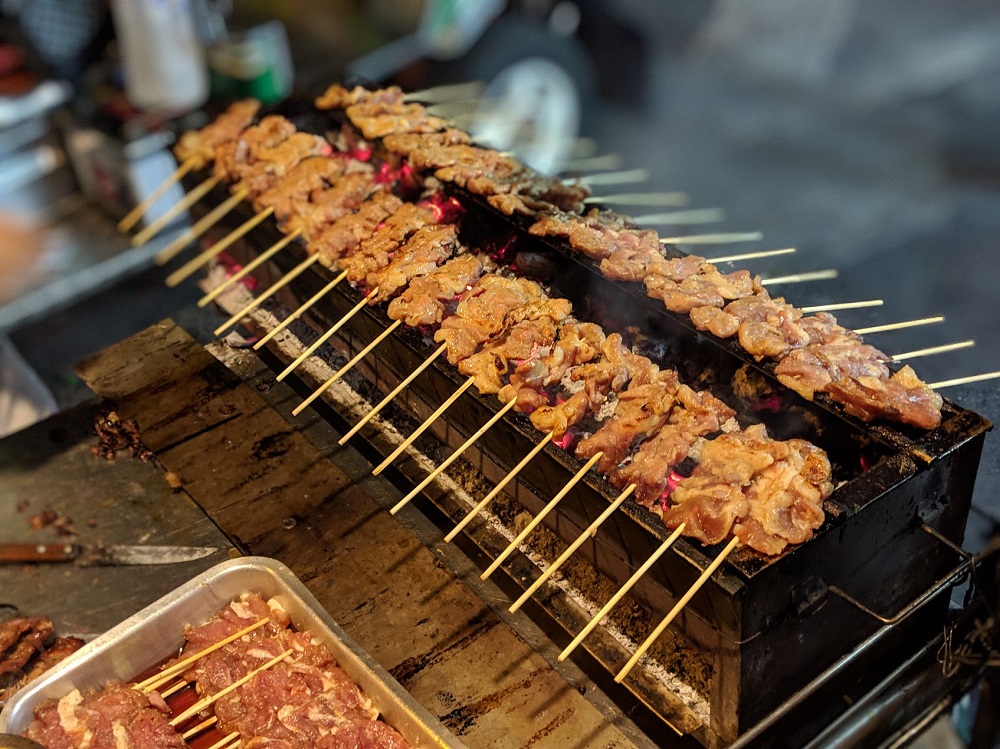
There are many reasons why Bangkok is one of the most exciting cities in Asia, but first and foremost would be the city’s spectacular street food culture. The bustling Thai city is often seen as a reference point for diverse and delicious street food, maintaining a reputation for no fuss curb-side dining that has endeared generations, serving up everything from classic pad Thai and grilled pork skewers, to chicken wing soup and crab omelette.
It is said that there are in excess of 500,000 street food vendors in the city alone. They stand scattered around the city at all hours of the day and night, ready and willing to serve up historic recipes to hungry locals and tourists begging to get a true taste of Bangkok. That’s a lot of choices for the visitor who only has a limited time in this fascinating, and often overwhelmingly busy, city. Not to worry.
I’ve put together a handful of our favourite street food spots in Bangkok, whether they take the form of the classic roaming cart, or a quaint and lively shophouse. Take note of these, plus a few tips to help you explore BKK street food like a pro, and stay completely healthy while doing so – no one wants to spend their holiday hugging the hotel toilet, do they?
Nai Mong Hoy Tod
Of course at least one spot in Bangkok’s famous Yarowat area had to make it. This are of narrow streets is the city’s Chinatown, and is an absolute smorgasbord of incredible traditional shophouses and street food stalls. It’s hard to go wrong in this bustling neighbourhood, but perhaps one of the best known spots is Nai Mong Hoy Tod, where the specialty is – as the name implies – hoy tod (fried oyster omelette), attracting plenty of locals between 11am and 9:30pm daily. There’s also a version with mussels, but oyster is where it’s at if you really want the full experience.
Around 70 baht (AU$3.40) will get you an omelette packed with enormous saucy oysters bursting out of the super crispy yellow blankets. It’s quite oily, but packed with flavour and kept consistent for more than three decades. I’ve visited twice, and can confidently say this is some of the best street food that I’ve tried in all of Thailand. Forget kebabs or burgers, this is real hangover food in South-East Asia.
How To Find It: Nai Mong Hoy Tod is located at the edge of Chinatown, in an old shopfront at 539 Phlap Phla Chai Rd.
Tip: Pack some Travelan
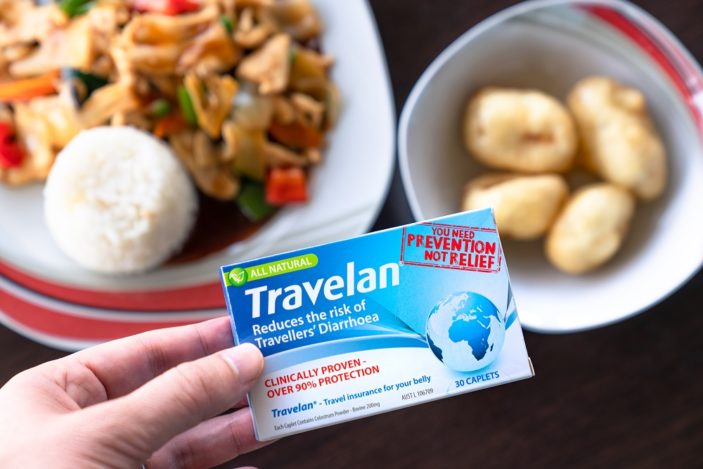
Though Bangkok’s street food is largely fine in terms of hygiene, there are still precautions any smart traveller should take. And it goes beyond just taking hand sanitizer with you wherever you go.
While some may call it paranoia, it’s wise to be vigilant about your health when giving putting yourself in the hands of any country’s street food scene. As mentioned above, you don’t want to be spending any more time in a bathroom (or even worse, a hospital) than you should. Luckily there’s a big, proactive step you can take to avoid the rightfully feared bout of Traveller’s Diarrhea.
Before you head off on the trip, grab a packet of Travelan from your local pharmacy. It’s an over-the-counter product that happens to be scientifically proven (you can read a bit more about it HERE) to reduce the risk of Traveller’s Diarrhea. It’s been indicated to offer up to 90% protection against the joy-killing condition caused by infection with E.coli, so you can nip any issues in the bud before they start.
If anything, it’ll also give you the confidence to try some new foods if you have concerns about hygiene.
Note that you can also get Travelan on Amazon. Just make sure you take the capsules before meals. For more information on it click HERE
Guaythiew Pik Gai Sai Nampung
Another legend amongst locals. Guaythiew Pik Gai Sai Nampung is a small, rustic shophouse serving up the absolute best guaythiew pik gai (chicken wings in broth with cowslip blossoms) you will ever have. There’s no exception or compromise here, with the shophouse dominating morning hours with queues snaking up and down the lower Sukhumvit area (the shophouse is located at 392/20 Sukhumvit Road between Sois 18 and 20 – it’s opposite the Radisson Blu hotel and the closest BTS station is Asoke).
The exceptional, slightly honeyed chicken wings are served with the soup in a separate bowl, sporting a flavour that is consistent across the juicy skin thanks to a marinade of fish sauce (Thai fish sauce is mind-blowing in and of itself), chilli sauce and some spaces. The chicken wings are also braised, so the texture is incredibly soft and tender. If you’re not keen on the soup, there’s also a dry version served with bean sprouts and long beans.
You can ask them to add any of six different types of noodles to the soup, including Giam ee (a hand-rolled noodle that’s a bit shorter and fatter than average) and sen lek noodles (the type that’s often found in pad Thai). You can also add other parts of the chicken to the broth, such as intestines.
You’re looking at around 42 baht per serving of guaythiew pik gai, and although the shophouse is open from 9am to 3pm, the chicken wings almost always sell out before (at the latest) 11:30am. There are other great things on the menu though, so even if you miss out it’s still well worth the trip.
How To Find It: Take the BTS to Asoke and walk down Sukhumvit Road between Sois 18 and 20. You’ll find the small shophouse opposite Radisson Blu (and if it’s anytime before 11:30am, just look for the queue made up mostly of locals and a few in-the-know expats).
Tip: Look For the Queues
If you’re a food enthusiast travelling Asia then waiting in queues is part of that lifestyle. There’s no question about it, and those who will complain about a long wait need not apply. Just because it’s casual food, doesn’t mean it has to be fast food.
Don’t trust rating aggregators (unless you’re in Tokyo and using Tabelog), instead you should get used to judging the quality of a queue, over the quantity. Is it full of locals? That’s a bingo. It’s as simple as that, and while this is probably the most obvious tip on the list, it’s one that cannot be overlooked. If you’re walking along and see you a small shopfront or cart with the kind of queue you think you should join, don’t even think two seconds about it. Join. that. queue.
Moo Ping Hea Owen
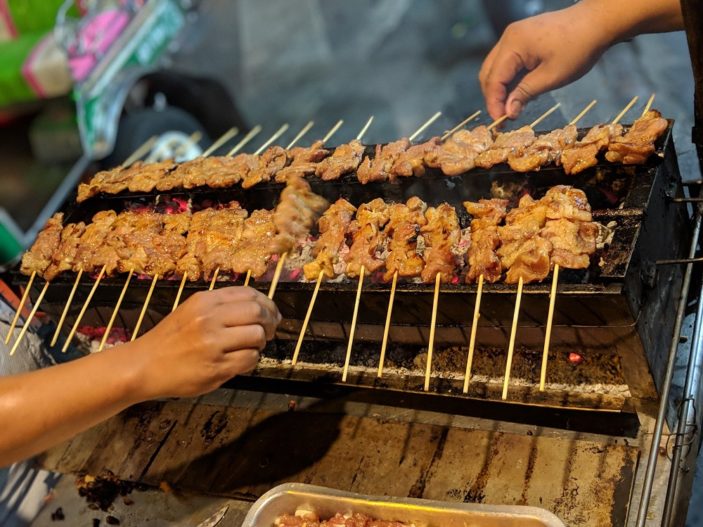
Let’s kick off with one of the best. This legendary stall has been a local favourite since the early 80s, serving up the most mind-blowing Thai-style grilled pork skewers for around 10 baht (AU$0.50) each.
One for the late-night crowd, the sometimes elusive cart pops up just outside of 7/11 on Silom Road at Soi Convent most nights between 10pm and 2am. Although do note that the piles of juicy pork waiting to be grilled right in front of you often sell out well before closing time.
There’s a sweet, tangy sauce that’s lathered generously onto these skewers, giving it a rich and robust flavour that drips off the succulent meat and dances across the tongue. Spice lovers will want to look to the condiment tray (most street stalls would have one) and add a bit of punch with the homemade chilli sauce, but there’s already enough flavour without it.
You’ll most likely need to wait in a snaking queue to grab some of these legendary skewers, but if you’re not so keen on staggering around the streets at night do note that Hea Owen’s popularity has seen them open a stall at the considerably brighter (and indoors) Central Embassy. Although here the sticks will be around 20 baht (AU$0.97 each).
How To Find It: Catch the BTS Sky Train to Sala Daeng Station or the MRT underground to Si Lom Station, and from there walk the short distance to the corner of Silom and Convent roads. The cart is usually located right outside the 7/11.
Tip: Observe, Observe, Observe
If you want to stay healthy then you’ve got to put in a bit of work. Be vigilant, but don’t be overly paranoid. If you’ve taken the first tip and popped in some Travelan before heading out then you’ve already done half the work. The other half is up to you: observe, observe, observe.
Watch the food being cooked; is the vendor using gloves, and if not, are they touching their face between handling food? Watch other customers being served; is the vendor handling cash and food with the same hand? Also take a look at the condiment tray; is it dirty or is it well-maintained? If it’s clean, then this should be taken as a green-light, because if they have time to clean that, then they care about hygiene.
Raan Jay Fai
Raan Jay Fai is perhaps the most well-known for all of Bangkok’s street food. At least around the world, considering it was awarded a Michelin star in 2017. The stately Supinya Junsuta (nicknamed Jay Fai), an elderly woman who runs the restaurant and cooks every single meal, watches over her iconic kee mao talay (smokey seafood drunken noodles) and khai jeaw poo (crispy crab omelettes) from 3pm to 2am six days a week, making sure these meticulously prepared signatures are up to a certain standard.
At 1,000 baht (almost AU$50), this is one of the most pricey casual meals you can have. Combined with the hour-plus long wait, the effort can be off-putting to some, but food enthusiasts persevere every night, and so should you. These things, especially the sweet, round-ish crab omelettes, are well worth anything kind of wait and price. I’d go so far as to say these is one of the best things I’ve eaten across Asia.
Although do note that the increased popularity has added much pressure to the restaurant and its eponymous cook. As such, I’d recommend trying to make an e-mail booking far in advance (and accepting defeat if you can’t). Also, don’t be one of those people who just stands around gawking taking photos for the sake of it. The restaurant is busy enough.
How To Find It: Raan Jan Fai is located at 327 Maha Chai Road, Bangkok near the street’s intersection with Samranrat Road. It’s best to get off at either BTS National Stadium or MRT Hua Lamphong and walk.
Tip: Eat At Specialised Stalls
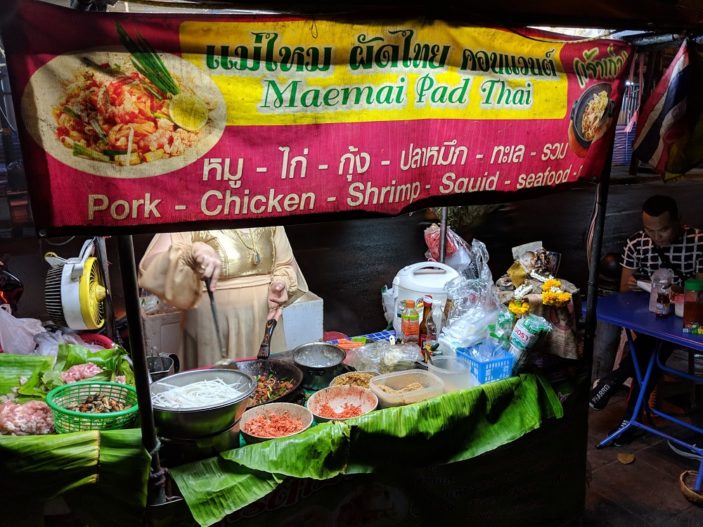
There are plenty of vendors around Bangkok that attempt to squeeze as many essential Thai dishes onto one more. But these substantial lists are best pushed further down your to-do list in favour of stalls that specialise in just one or two dishes, or are known for one particular signature.
Yes, it’s tempting to stop by a stall that offers plenty of things so you can try more in one go, but the general rule of thumb (with pretty much anything) is “more equals less”. Less attention, less technique, less time, less flavour. Plus, if they are only specialising in one or two dishes, chances are more focus will be given to cleanliness and fresh ingredients. These are usually the ones that only have the ingredients necessary to make that particular dish, which means there’s less produce sitting around doing nothing.
Som Tum Jae Daeng
Head to the Sam Yan area and make a bee-line straight for this locally adored shopfront waving the flag high for North-Eastern Thai food from the Isan province. Specifically, that means som tum (green papaya salad) which is one of the country’s most beloved dishes, whether as a side or a main.
Be warned though, this salad can get quite hot, and Jae Daeng don’t compromise on their technique or their quality. Order up the fermented green papaya salad and make sure to get some of those deliciously salty anchovies on top to round-out the complex flavour profile. That should be your priority, then you can start ordering up accompanying dishes like the fleshy snakehead fish that’s been stuffed with herbs, some of those incredibly juicy grilled chicken thighs, and kor moo yang (charcoal grilled pork neck). It’s also worth grabbing a catfish salad for around 70 baht (AU$3.00), which will give you some of the papaya salad loaded on top of a pile of moreish deep-fried catfish.
Note that there’s no English menu, as it’s almost exclusively locals who make this a staple between the opening hours of 10am and 3:30pm (closed Sundays, as with most of the best spots).
How To Find It: Som Tum Jae Daeng is located at 209 Soi Chula, 48 Khwaeng Wang Mai, Khet Pathum Wan, Bangkok.
Tip: Head to Sook Siam
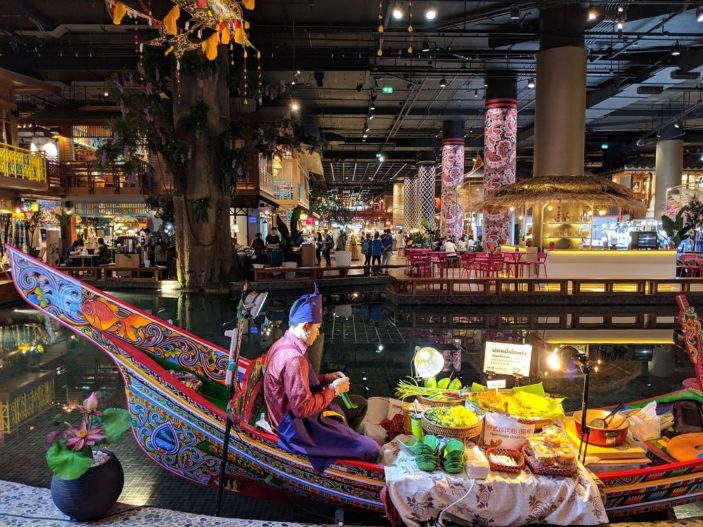
After all that, if you still feel a bit nervous about completely giving yourself over to Bangkok’s vibrant street food scene, then head to Iconsiam. The brand new luxury development stands stately by the waterside, and it’s quite easy to get to. Yes, a luxury mall is far from the gritty narrow roads where the best street food is found, but they’ve got one magnificent food hall that buzzes all day with energy.
It’s called Sook Siam, and remarkably the entire place is modelled after Thailand’s famous floating markets. The design and layout is like no other, and the food on offer is a comprehensive overview that represents all regions of Thailand. And it’s rare to find somewhere in Bangkok that embraces every single part of the country. The showcase of food is extraordinary, so take some time and visit all the indoor stalls to get familiar with what kind of street food you can expect in the country.
Then maybe you’ll develop a taste worth risking any perceived risk of trying the real Bangkok street food.
This article was made possible with the support of Tourism Authority of Thailand and Travelan. All opinions, food eaten and suggestions are that of the writers.
